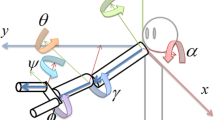Abstract
Originating from a viewpoint that complex/chaotic dynamics would play an important role in biological system including brains, chaotic dynamics introduced in a recurrent neural network was applied to control. The results of computer experiment was successfully implemented into a novel autonomous roving robot, which can only catch rough target information with uncertainty by a few sensors. It was employed to solve practical two-dimensional mazes using adaptive neural dynamics generated by the recurrent neural network in which four prototype simple motions are embedded. Adaptive switching of a system parameter in the neural network results in stationary motion or chaotic motion depending on dynamical situations. The results of hardware implementation and practical experiment using it show that, in given two-dimensional mazes, the robot can successfully avoid obstacles and reach the target. Therefore, we believe that chaotic dynamics has novel potential capability in controlling, and could be utilized to practical engineering application.
Similar content being viewed by others
References
Aihara K, Takabe T, Toyoda M (1990) Chaotic Neural Networks. Phys Lett A 114: 333–340
Babloyantz A, Destexhe A (1986) Low-dimensional chaos in an instance of epilepsy. Proc Natl Acad Sci USA 83: 3513–3517
Blum L (1994) A theory of computation and complexity over the real numbers. In: Yamaguti M (ed) Towards the harnessing of chaos. Proceedings of the 7th Toyota Conference. Elsevier Science B.V., Amsterdam, pp 11–27
Fujii H, Itoh H, Ichinose N, Tsukada M (1996) Dynamical cell assembly hypothesis—theoretical possibility of spatiotemporal coding in the cortex. Neural Netw 9: 1303–1350
Haken H (1996) Principles of brain functioning. Springer, Berlin
Horchler A, Reeve R, Webb B, Quinn R (2004) Robot phonotaxis in the wild: a biologically inspired approach to outdoor sound localization. Adv Robot 18(8): 801–816
Huber F, Thorson H (1985) Cricket auditory communication. Sci Am 253: 60–68
Kaneko K, Tsuda I (2003) Chaotic itinerancy. Chaos 13(3): 926–936
Kuroiwa J, Nara S, Aihara K (1999) Functional possibility of chaotic behaviour in a single chaotic neuron model for dynamical signal processing elements. In: 1999 IEEE international conference on systems, man, and cybernetics (SMC’99), Tokyo, vol 1, p 290
Li Y, Nara S (2008) Novel tracking function of moving target using chaotic dynamics in a recurrent neural network model. Cogn Neurodyn 2: 39–48
Manoonpong P, Pasemann F, Fischer J, Roth H (2005) Neural processing of auditory signals and modular neural control for sound tropism of walking machines. Int J Adv Robot Syst 2(3): 223–234
Nara S, Davis P (1992) Chaotic wandering and search in a cycle memory neural network. Prog Theor Phys 88: 845–855
Nara S, Davis P, Kawachi M, Totuji H (1993) Memory search using complex dynamics in a recurrent neural network model. Neural Netw 6: 963–973
Nara S, Davis P, Kawachi M, Totuji H (1995) Chaotic memory dynamics in a recurrent neural network with cycle memories embedded by pseudo-inverse method. Int J Bifurcat Chaos Appl Sci Eng 5: 1205–1212
Nara S, Davis P (1997) Learning feature constraints in a chaotic neural memory. Phys Rev E 55: 826–830
Nara S (2003) Can potentially useful dynamics to solve complex problems emerge from constrained chaos and/or chaotic itinerancy?. Chaos 13(3): 1110–1121
Nicolelis M (2001) Actions from thoughts. Nature 409: 403–407
Reeve R, Webb B (2003) New neural circuits for robot phonotaxis. Philos Trans R Soc Lond A 361: 2245–2266
Skarda CA, Freeman WJ (1987) How brains make chaos in order to make sense of the world. Behav Brain Sci 10: 161–195
Suemitsu Y, Nara S (2003) A note on time delayed effect in a recurrent neural network model. Neural Comput Appl 11(3&4): 137–143
Suemitsu Y, Nara S (2004) A solution for two-dimensional mazes with use of chaotic dynamics in a recurrent neural network model. Neural Comput 16(9): 1943–1957
Tsuda I (1991) Chaotic itinerancy as a dynamical basis of Hermeneutics in brain and mind. World Futures 32: 167–184
Tsuda I (2001) Toward an interpretation of dynamic neural activity in terms of chaotic dynamical systems. Behav Brain Sci 24(5): 793–847
Weber T, Thorson J (1988) Auditory behavior of the cricket. J Comp Physiol A 163: 13–22
Wessberg J, Stambaugh C, Kralik J, Beck P, Laubach M, Chapin J, Kim J, Biggs S, Srinivasan M, Nicolelis M (2000) Real-time prediction of hand trajectory by ensembles of cortical neurons in primates. Nature 408: 361–365
Author information
Authors and Affiliations
Corresponding author
Electronic Supplementary Material
The Below is the Electronic Supplementary Material.
ESM 1 (MPG 2,275 kb)
ESM 2 (MPG 4,542 kb)
ESM 3 (MPG 4,324 kb)
Rights and permissions
About this article
Cite this article
Li, Y., Kurata, S., Morita, S. et al. Application of chaotic dynamics in a recurrent neural network to control: hardware implementation into a novel autonomous roving robot. Biol Cybern 99, 185–196 (2008). https://doi.org/10.1007/s00422-008-0249-6
Received:
Accepted:
Published:
Issue Date:
DOI: https://doi.org/10.1007/s00422-008-0249-6




